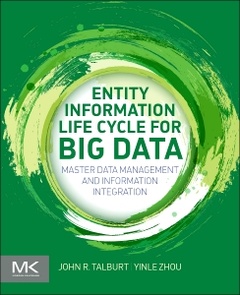Description
Entity Information Life Cycle for Big Data
Master Data Management and Information Integration
Authors: Talburt John R., Zhou Yinle
Language: English
Subjects for Entity Information Life Cycle for Big Data:
Keywords
ANSI; Attribute-based Cluster Project; batch access; benchmarking; Big Data; Blocking; Clerical Review Indicators; closed universe; Confirmation Assertions; Correction Assertions; CRUD; CSRUD; Data Governance; data matching; Data profiling; Data Stewardship; Deterministic Matching; EIIM; Entity Identity Information; entity identity information management; Entity identity structures; Fellegi-Sunter model; Graph Component; Hadoop Map/Reduce; Identity knowledge base; Identity resolution; Information Life Cycle; interactive access; Inverted Indexing; ISO; ISO 22745; ISO 8000; Master data; master data management; Match Key; MDM; MDM architectures; One-Pass Algorithm; open universe; POSMAD; Probabilistic Matching; R-Swoosh Algorithm; RDM; Record-based Cluster Projection; reference data management; review indicators; Semantic Encoding; SERF; Stanford entity resolution framework; truth sets
56.19 €
In Print (Delivery period: 14 days).
Add to cartSupport: Print on demand
Description
/li>Contents
/li>Biography
/li>Comment
/li>
Entity Information Life Cycle for Big Data walks you through the ins and outs of managing entity information so you can successfully achieve master data management (MDM) in the era of big data. This book explains big data?s impact on MDM and the critical role of entity information management system (EIMS) in successful MDM. Expert authors Dr. John R. Talburt and Dr. Yinle Zhou provide a thorough background in the principles of managing the entity information life cycle and provide practical tips and techniques for implementing an EIMS, strategies for exploiting distributed processing to handle big data for EIMS, and examples from real applications. Additional material on the theory of EIIM and methods for assessing and evaluating EIMS performance also make this book appropriate for use as a textbook in courses on entity and identity management, data management, customer relationship management (CRM), and related topics.
1. The Value Proposition for MDM and Big Data?2. What is entity information lifecycle management?3. Metrics for Quantifying Entity Integrity4. Identity Capture Deep Dive5. Identity Archiving and Disposal6. Identity Resolution7. Identity Update8. CSRUD for Big Data9. Toward Big Data Analytics10. Final Thoughts
Dr. Yinle Zhou is an IBM software architect and data scientist in the InfoSphere MDM development group in Austin, Texas, and also serves as an Affiliate Member of the Graduate Faculty at University of Arkansas at Little Rock (UALR). Dr. Zhou holds a PhD in Integrated Computing with Emphasis in Information Quality (IQ) from UALR where her doctoral research focused on modeling the management of entity identity information in entity resolution systems. She also holds a Master of Science in Information Quality from UALR, a Bachelor of Business Administration in Electronic Commerce from Nanjing University in China, and the Information Quality Certified Professional (IQCP) credential issued by the International Association for Information and Data Quality (IAIDQ). Her research and publications are in areas of information quality, identity management, entity and identity resolution, and social computing
- Explains the business value and impact of entity information management system (EIMS) and directly addresses the problem of EIMS design and operation, a critical issue organizations face when implementing MDM systems
- Offers practical guidance to help you design and build an EIM system that will successfully handle big data
- Details how to measure and evaluate entity integrity in MDM systems and explains the principles and processes that comprise EIM
- Provides an understanding of features and functions an EIM system should have that will assist in evaluating commercial EIM systems
- Includes chapter review questions, exercises, tips, and free downloads of demonstrations that use the OYSTER open source EIM system
- Executable code (Java .jar files), control scripts, and synthetic input data illustrate various aspects of CSRUD life cycle such as identity capture, identity update, and assertions



